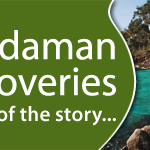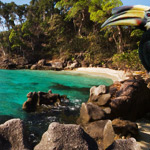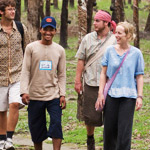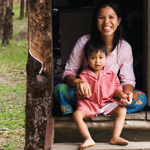Andaman Discoveries Blog
Tuesday, May 8, 2012
Nicole
Hello world!
Labels: community-based tourism, ecotourism, responsible tourism, Thai culture
Monday, August 16, 2010
Famous Thai Food
Delicious Thai Cooking Class
KanoomJeen Saonam - Rice Noodle with Coconut Milk and Pineapple
Ingredients:
1 kg rice noodle
1 head pineapple
¼ cup ground dried shrimps
½ cup thin slice ginger
7 small head garlic
¼ cup of chili
Soy sauce, lime , sugar
Directions:
1.Peel the pineapple and remove eyes. Coarsely chop the pineapple
2.Peel the garlic and thin slice widthwise remove to the plate
3.Peel the ginger and thin slice lengthwise remove to the plate
4.Thin slice the chili and remove into the plate
5.Ground dried shrimp and remove into the bowl
6.Mixed soy sauce, lime and sugar in a bowl add some chili and garlic
7.Heat the coconut milk in a small pot, add some salt and stir for 5 minutes remove from the heat and let it cool
8.Served rice noodle with pineapple chopped, garlic, ginger, chili, ground dried shrimp, sauces and on top coconut milk.
Labels: staff development, Thai culture, Thai food
Monday, January 18, 2010
Seeing is Believing
Visit us in 2010!
As a follower of our work, you are aware of the remarkable recovery of the villages of the North Andaman region in the years since the tsunami. We continue to extend the personal invitation to come and see for yourself the fruits of the work you're supporting. On an Andaman Discoveries Village Tour, you will relax on a pristine golden beach where the rainforest meets the sea, and experience the traditional livelihoods of these small rural communities firsthand. The villagers in these idyllic communities invite you to participate in a genuine cultural exchange that directly supports their long-term strategy to reduce pressure on their natural resources and allow fish populations to recover.
As an incentive, we're offering special cultural homestay tours each month from now through April. These small group tours provide an affordable way for individuals, budget travelers, and families to experience the magic of a cultural tour in this fascinating and beautiful area of Southern Thailand. You'll participate in activities such as fishing on the beach, exploring mangrove forests by long-tail boat, making your very own batik painting, and preparing a home-cooked Thai meal. Group sizes are kept deliberately small to enhance the experience for both guests and villagers alike.
For more information, please contact us.
Labels: cultural tours, North Andaman Region, special promotions, Thai culture
Monday, July 13, 2009
Learning about Elephants
 Experiences in Thailand
Experiences in ThailandBy Leslie Welshimer
Eager visitors flock to Thailand to experience the country’s welcoming people, stunning scenery, appetizing cuisine and the chance to get up close with an elephant (Chang in Thai).
In choosing where to spend time with elephants, it was important to me to choose an organization that was ethical and truly helping elephants. I’d read rave reviews about the Elephant Nature Park near Chiang Mai, so after some investigation, I booked the “Learning Elephant” day tour.
The Elephant Nature Park is a sanctuary and rescue centre for about 30 elephants. It’s located in a breathtaking valley. The park is bordered by a river and encircled by forested mountains in Chiang Mai province.

Being in the presence of elephants was humbling and mesmerizing. We were given a sizable bucket full of bananas, corn and squash to feed one elephant. The elephant looked at us with kind eyes and gently took food from our hands.
After feeding, we had some downtime to relax and watch the elephants stroll about the park. I would have been happy to just sit and watch them for hours. The interaction in activities, like feeding and bathing, was just icing on the cake.
The bathing was one of our favorite parts, as we had the opportunity to wade in the water and immerse with the elephants. Buckets and brushes were distributed to volunteers and guests to split the duties.
The lunch that we were provided was astounding. It was a full buffet of 20+ options. The feast would leave even the most selective eater with a beaming smile and full belly.
The afternoon brought a second round of feeding and bathing for the elephants and more enjoyment watching the elephants roam in the peaceful solitude of the park.
There was an educational element woven throughout the day’s events, including about an hour where we watched a documentary about Asian elephants. The documentary was powerful, eye opening and inspired us to want to help.
The memorable day concluded with transport back to our guesthouse. Our exceptional guide, Chet, gave us a chat about how people can make a difference and concluded by saying, “Take care of your health and your love. Make the world smile.”
If you’re interested in visiting the Elephant Nature Park, click here to learn more.
Labels: Elephants, Thai culture, Thailand
Friday, July 3, 2009
Rebecca’s Journal – Life in Kuraburi
When I first saw Kuraburi, I wondered, where the rest of it was. “Is this it?” I asked. It took me a few days to adjust to a life that vastly contrasts from my home in England.
Eventually, I found that while the town is small, it had more than its fair share of attractions to keep me entertained. It has a lovely atmosphere and buzz about it that I hadn’t experienced anywhere before.
Spending one month in Kuraburi gave me an insight into Thai life. I never would have experienced this viewpoint had I only visited the tourist hotspots of Thailand.
 |
| Kelly, Karen and Rebecca relish the sunset at Ao Khoei beach near Kuraburi. |
Kuraburi gave me the chance to visit the morning and night markets, eat an abundance of traditional Thai dishes and taste exotic fruits that I didn’t know existed.
Community aerobics was one of my favorite activities. Dancing, sweating and enjoying music with local Thai woman was the ideal conclusion to a day of teaching. The classes are held Monday to Friday at about 5:15 p.m.
The month in Kuraburi was thoroughly enjoyable. I’m glad that my travels began in Kuraburi with Andaman Discoveries and of course, Gary the Gecko.
Labels: Kuraburi, Thai culture
Wednesday, July 1, 2009
Community-Based Tourism Pilot Tour: The Real Value of a Home
It’s hard to explain what makes a home inviting and exude warmth. Is it the comfy sofa, the pictures on the wall, or a manicured lawn?
I believe that people create the feel of a place (okay, so architecture is a big player too, but if you fill the most beautiful building in the world with grumps, it’s not going to be a fun place).
Have you ever walked into a work place, and felt tension so thick, you could cut it with a knife? No one is talking, but yet you feel the emotion of the people.
| Ban Lion Village |
Ban Lion showed me what makes a place. The people, with genuine warmth in their eyes, a smile and the kindness to share their lives made their residences inviting, not the homes lined up like an Excel spreadsheet.
Our destination for a two-day pilot tour in June was Ban Lion, a village located on the northwest side of Koh Prathong in Phang Nga Province. The residents are a collective of people from different villages who were affected by the tsunami in 2004. The homes in the village were built with the support of Lions Club International.
We were greeted while unloading from the boat. I was instantly impressed that the villagers came to us, versus waiting for us to come to them.
The home style in Ban Lion likely contrasts the image of Thai homes most foreigners have in their heads. My first thought upon arrival was, “Am I in an American suburb?” Completely identical homes are in clean, distinct lines.
Any confusion I had was replaced and trumped ten-fold by the people. They were so determined to make us feel at home. Our homestay hosts were two, 20-year-old girls, who work at the nearby Golden Buddha Beach Resort.
The first day we explored sea grass at low tide where pools were full of more star fish than I’d ever seen at once. We visited the old village, called Pak Jok. The tsunami devastated Pak Jok Village, leaving only small sections of concrete road and the bases of a few buildings. From there, we walked to the beach for sunset.
| Sun Dew Plant |
On day two, we took a short tractor ride to the golden grass fields. Our energetic guides’ passion for the area was contagious. They took special care to point out each detail. My favorite plant was the sun dew, which has a trap for insects to fall into to provide the plant with nutrients.
There was a brief discussion at the end of the tour where we gave our feedback on everything from the food to activities. My overall feedback was that it’s the seemingly small stuff that makes a tour, a restaurant, a hotel or the world work. Life is all about the difference between someone pointing down the street, when you’re new in town and ask where post office is, versus someone walking you there and buying you a cup of coffee.
-Leslie Welshimer
Labels: community tourism, homestay, Thai culture, Thailand, Thailand homestay
Friday, June 26, 2009
A different kind of guide book: Travelers’ Tales Thailand
Experiences in Thailand
By Leslie Welshimer
Traveling to unfamiliar places can be daunting or delightful. Getting answers to important questions in advance increases the odds that one won’t miss out on amazing experiences or unknowingly offend someone.
 Before visiting a new place, I’ve found it to be immensely helpful to read and study up on topics like the culture, geography, local holidays and weather. Otherwise, you may travel six hours to visit a place, like the Surin Islands, only to learn it’s closed for the rainy season.
Before visiting a new place, I’ve found it to be immensely helpful to read and study up on topics like the culture, geography, local holidays and weather. Otherwise, you may travel six hours to visit a place, like the Surin Islands, only to learn it’s closed for the rainy season.I came to Thailand in February 2009. In an effort to minimize my footprint on the Thai culture, I was determined to gain as much of an understanding as possible of Thailand. My goal was to arm myself with an arsenal of literature to educate myself before departure and along the way. I made a pact to only read books related to Thailand while in the country.
 When I departed Seattle, my luggage contained four books:
When I departed Seattle, my luggage contained four books:- A History of Thailand by Chris Baker and Pasuk Phongpaichit
- Buddhism for Beginners by Thubten Chodron
- Lonely Planet Thailand guidebook
There was a fifth book I wanted before departure, but I was unable to secure it. Luck was in my favor because in March, the Hoyt family visited Andaman Discoveries. The family came with the book, Travelers’ Tales Thailand, edited by James O'Reilly and Larry Habegger. The Hoyts were finished reading the book and asked if anyone would like it. I raised my hand like an anxious grade school kid at a chance for a cupcake.
Travelers’ Tales Thailand is a Lowell Thomas Award Winner - Best Travel Book. It is a series of short stories or excerpts from complete books by highly regarded authors like Pico Iyer, Diane Summers and Jeff Greenwald.
I finished Travelers’ Tales Thailand in May. It provided an overview of Thailand with entertaining personal stories. The book reminded me a bit of the Chicken Soup for the Soul Series, but targeted at travelers.
It made the perfect book, as I could pick it up and read one story or more if I wanted. My only regret is that I didn’t read it before I departed Seattle. It contained enlightening tidbits about the essence of Thailand that would have helped shape my expectations beforehand.
Travelers' Tales has more than 100 titles in print. I plan to make it a tradition to see if there is a Travelers’ Tales book available on future travels.
What’s next on my Thailand-immersion reading list? Kelly May loaned me her copies of, Culture Shock: Thailand (Culture Shock! A Survival Guide to Customs & Etiquette) by Robert Cooper and Nanthapa Cooper, and Letters from Thailand, by Botan and translated by Susan Fulop Kepner.
What is your favorite Thailand-related book? If there is a book that you recommend for Thailand travelers, please feel free to comment on the blog or contact us to share your thoughts.
Labels: Kelly May, Thai culture, Thailand
Wednesday, March 18, 2009
Homestay with Andaman Discoveries
Reposted from the Briefcase to BACKPACK Blog
December 9, 2008 by Michaela Potter
Michael and I traveled to Thailand as part of our 2007 career break. The following is an excerpt from our travel blog.
 Of all the places we would visit on this trip, the last place I thought Michael would be able to relate to the most was a small Muslim Village in Thailand. But surprisingly, he eased right into sleeping on a mattress on a floor under mosquito netting with roosters crowing at 2am, speaking a completely different language from anyone else around us, and feeding baby goats twice a day. But he easily compared it to consulting -- traveling endlessly from one hotel to the next, needing to learn a new dialect or corporate speak, and understanding a new corporate environment and supporting it. Makes perfect sense.
Of all the places we would visit on this trip, the last place I thought Michael would be able to relate to the most was a small Muslim Village in Thailand. But surprisingly, he eased right into sleeping on a mattress on a floor under mosquito netting with roosters crowing at 2am, speaking a completely different language from anyone else around us, and feeding baby goats twice a day. But he easily compared it to consulting -- traveling endlessly from one hotel to the next, needing to learn a new dialect or corporate speak, and understanding a new corporate environment and supporting it. Makes perfect sense.Our stay in Tung Nang Dam was thanks to Andaman Discoveries -- an offshoot of the North Andaman Tsunami Relief (NATR) organization. As their website states “we started by doing relief projects FOR community members, then we progressed to development projects WITH community members, now we are assisting with projects led BY community members.”
 We were to stay four days/three nights in this small Muslim village, which consisted of just 35 homes and a population of 115. Even though Tung Nang Dam is protected by mangroves, (hence you can only access it by boat), and no homes or lives were lost during the tsunami, the fishermen lost their boats and livelihood and many fish farms were damaged beyond repair. And as part of the evolution of NATR “villagers decided that community-based tourism would allow them to generate additional income and support the community of their traditions, culture and lifestyle. Community-based tourism could fit into their lives, and not force them to sacrifice their traditional lifestyles for the sake of tourists.”
We were to stay four days/three nights in this small Muslim village, which consisted of just 35 homes and a population of 115. Even though Tung Nang Dam is protected by mangroves, (hence you can only access it by boat), and no homes or lives were lost during the tsunami, the fishermen lost their boats and livelihood and many fish farms were damaged beyond repair. And as part of the evolution of NATR “villagers decided that community-based tourism would allow them to generate additional income and support the community of their traditions, culture and lifestyle. Community-based tourism could fit into their lives, and not force them to sacrifice their traditional lifestyles for the sake of tourists.”Our host, P’Noi, and her family were the perfect hosts for this experience. P’Noi was part of the NATR seven-month vocational training program that focused on using tourism as a tool for community development; cultural, environmental and adventure-based guiding methods; first aid and safety training; English language and computer skills; small business management and entrepreneurial training; and hospitality and travel planning skills.
 One of P’Noi’s projects was an orchid conservation farm. Orchids in Tung Nang Dam are becoming increasingly rare, as they are popular decorations for homes and restaurants. Over-harvesting by mainland people has become a big problem in the jungles of the village. P’Noi has developed a program of incubating orchid cuttings on her farm and transplanting them to the jungle once they are mature. In addition, volunteers add their names, hometowns and date of planting on a plaque next to the orchid in hopes of dissuading people from cutting them. We did our part by planting cuttings in coconut planters with hopes of them returning to the jungle in the future. We also went on a jungle trek to fertilize those orchids that have been returned.
One of P’Noi’s projects was an orchid conservation farm. Orchids in Tung Nang Dam are becoming increasingly rare, as they are popular decorations for homes and restaurants. Over-harvesting by mainland people has become a big problem in the jungles of the village. P’Noi has developed a program of incubating orchid cuttings on her farm and transplanting them to the jungle once they are mature. In addition, volunteers add their names, hometowns and date of planting on a plaque next to the orchid in hopes of dissuading people from cutting them. We did our part by planting cuttings in coconut planters with hopes of them returning to the jungle in the future. We also went on a jungle trek to fertilize those orchids that have been returned.P’Noi and her family also had a goat farm, so every afternoon we would help shepherd them into their homes for the night as well as feeding the baby goats by bottle. Michael quickly took to this chore and had a few favorite kids that would nip at his feet for more. Another cultural activity that P’Noi shared with us was cooking. She shared with us how to make the Thai equivalent of a small pancake, guided us in cooking a seafood lunch, and even grilled oysters on a fire with her brothers.
 Of course the activities were just a side to the actual experience of living within a completely different environment, learning to communicate in broken Thai and sign language, and placing ourselves out of our comfort zone. But as much as we struggled in this new environment, the fact that these people, who come from a very shy culture and have to learn much more in order to accommodate us, opened up their homes and lives to us was extremely humbling.
Of course the activities were just a side to the actual experience of living within a completely different environment, learning to communicate in broken Thai and sign language, and placing ourselves out of our comfort zone. But as much as we struggled in this new environment, the fact that these people, who come from a very shy culture and have to learn much more in order to accommodate us, opened up their homes and lives to us was extremely humbling.Labels: Thai culture, Thailand homestay, Tung Nang Dam, Village Tours
Tuesday, March 17, 2009
Gin Khao Reu Yang?
 Experiences in Thailand
Experiences in ThailandBy Leslie Welshimer
It began with an intense craving for American food – a meal of a tuna sandwich, fries and a salad.
As I was savoring my meal, another farang smirked and laughed as he walked by my table, mocking my choice of dinner. And, so it began. March 6 marked the beginning of a one-month pact to eat only local cuisine in Kuraburi.
Prior to living in Thailand, I too mocked the thought of travelers dining on Western food abroad. Then by week three in Thailand, it occurred to me that I had been a giant, judgmental hypocrite for mocking others.
| Week one of Western-food free month included a visit to Tung Dap village where we feasted on crab, squid and fresh coconut for a beverage. |
It had never occurred to me that the ability to get nearly any type of food, at any time, is a luxury. Yes, I realized, I had taken that delicious, juicy burrito, the size of a baby, for granted. Gorditos, please forgive me.
Other than a Gorditos-absent environment, what is different about eating in Thailand? For starters, Thai food is generally eaten with a fork and a spoon. The spoon is the star of the show, bringing the food to your mouth. The fork, held in the left hand, is used like a knife in Western cultures to push food into the spoon. Chopsticks are used rarely, primarily for the consumption of noodle soups.
Rice is a beloved food here. It is so beloved that the phrase for, “have you eaten yet,” is “gin khao reu yang" or “have you had rice yet.”
 |
| Delicious waffles are sold at the Kuraburi morning market. |
Food is eaten slowly, savored. The sharing of food with others is part of the fun. When eating with Thais, the concept of “my entrée” is uncommon.
What will you share? A Thai meal commonly contains a soup, a curry dish with condiments, a dip with accompanying fish and vegetables. A spiced salad often replaces the curry dish. The overarching key is a balance and harmony of tastes and textures.
 |
| Fresh fruit is a treat at area markets. |
Tables full of fresh fruit and vegetables are a common site. There are several varieties of ready-to-eat food, including a noodle bar where you choose your toppings, fish cakes, barbecue chicken, sticky rice, fried bananas, and on and on.
My favorite meal from the morning market is a hot coffee (10 baht) and two waffles (10 baht), purchased from separate vendors. The grand total is less than $1 for a scrumptious breakfast.
 |
| Pad med mamuang (cashew chicken) with a fresh fruit smoothie at Cucina Andaburi. |
One observation I quickly made in Thailand was there aren’t designated foods for different meals. I see people eating the same noodle dishes for breakfast as they have for dinner. Barbecued chicken is seen at the morning and night market.
As far as ordering food, I’ve found it’s useful to know how to say and understand numbers in Thai. It’s helpful to know a few words like the names of foods you like or don’t like. If all else fails, pointing with a smile, rubbing your belly or using a phrasebook works.
 |
| Som tam is served at this atmosphere-filled restaurant on stilts. |
(Note: These experiences are from Kuraburi. Food in other parts of Thailand may vary)
Labels: Kuraburi, Thai culture, Thai food
Thursday, March 12, 2009
Muang Kluang Village
Andaman Discoveries introduces new destination
 Andaman Discoveries began working with Muang Kluang village last year as part of our effort to further diversify our award-winning village tours and homestay program. We're now ready to invite guests to spend time in this unique village. Working with Muang Kluang accomplishes two goals: expanding our support network of communities in the north Andaman area and offering more cultural activities for our visitors.
Andaman Discoveries began working with Muang Kluang village last year as part of our effort to further diversify our award-winning village tours and homestay program. We're now ready to invite guests to spend time in this unique village. Working with Muang Kluang accomplishes two goals: expanding our support network of communities in the north Andaman area and offering more cultural activities for our visitors.Andaman Discoveries invested extensive research into Muang Kluang by personally visiting the homestays, participating in village activities, and talking in-depth with homestay group coordinator Khun Jo Jo . We're confident that Andaman Discoveries’ guests will thoroughly enjoy spending time in Muang Kluang as well. The program will benefit the villagers through revenue generation that will go towards skills development and youth education.
In 2007, Muang Kluang received the accolade of “The Most Outstanding Community-based Tourism Award” by the Tourism Authority of Thailand. Andaman Discoveries is excited to offer this additional destination for guests seeking an authentic cultural experience. Please contact us for more information.
Labels: Muang Kluang, Thai culture, Thailand homestay, Village Tours
Subscribe to Posts [Atom]











